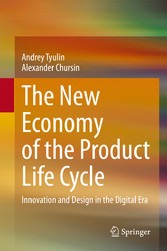Suchen und Finden
Service

The New Economy of the Product Life Cycle - Innovation and Design in the Digital Era
Andrey Tyulin, Alexander Chursin
Verlag Springer-Verlag, 2020
ISBN 9783030378141 , 406 Seiten
Format PDF, OL
Kopierschutz Wasserzeichen
Geräte
Mehr zum Inhalt

The New Economy of the Product Life Cycle - Innovation and Design in the Digital Era
Preface
5
Acknowledgment
7
Contents
8
Chapter 1: The Fundamentals of Product Life Cycle Economics
11
1.1 Evolution of the Product Life Cycle Theory: The Value and Goal of Rapid Development
11
1.2 Modern Product Life Cycle Management Approaches Used at Enterprises Practicing Digitized Work
24
1.2.1 Ensuring Stable Economic Development of an Organization
28
1.2.2 Building Mechanisms for Management of All Corporate Resources
31
1.2.3 Introduction of Advanced Product Design, Preproduction and Production Methods
34
1.3 Life Cycle Cost Calculation Methods
41
1.4 Informational Support of Automated Life Cycle Management Processes with the Use of Digital Technologies
51
References
59
Chapter 2: Rapid Development of an Organization
61
2.1 Rapid Development Management Law
61
2.2 Axiomatic Fundamentals of Management of Rapid Development
69
2.2.1 The Main Axioms of Rapid Development
69
2.2.2 Dynamic Mathematical Model
71
2.2.3 The Hysteresis Type Rapid Development Model
73
2.2.4 Management of Rapid Development in Imperfect Competition
74
2.2.5 General Management of Rapid Development in Imperfect Competition
75
2.2.6 A Relationship Between Rapid Development and Competence Management by Organizations
76
2.3 The Role of Competences in Management of Organizations´ Rapid Development
78
2.4 Strategic Rapid Development Approaches and Instruments for Science-Intensive Companies and Branches
87
Chapter 3: Personification of Needs as a Landmark for Creating Future Goods
98
3.1 Development of Technologies and Public Needs with Technological Waves and Information Technologies Enhancing in All Sphere...
98
3.2 Big Data Analysis-Based Methods of Assessment of the Effectiveness of Next-Generation Product Creation Processes Aimed at ...
114
3.3 The Economy-Production-Economy Cycle as a Form of Creating Competitive Goods
128
Chapter 4: Evaluation of an Organization´s Ability to Tailoring Production to Set Parameters
146
4.1 The Model and Dynamic Evaluation of Innovative Potential with Rapidly Growing Competitive Innovative Solutions and Expandi...
146
4.2 Modeling, Evaluation, and Prognosis of the Development of Unique Competences to Satisfy Prospective Needs and Ensure Their...
155
4.3 Resource Provision Models for Future Products
168
References
179
Chapter 5: A Product´s Image as a Basis of Its Competitiveness
180
5.1 Assessment of a Corporate Microenvironment and Its Role in Creating a Brand Image of a New Competitive Product
180
5.2 Use of Communication Methods and Technologies in Market and Consumer Demand Analysis When Shaping a Product´s Image
186
5.3 Competitiveness Management of Science-Intensive Products When Shaping Its Technical and Economic Image
196
Reference
202
Chapter 6: Economic Aspects of Developing Science-Intensive Products
203
6.1 Principles of Building an Intelligent Automated Product Life Cycle Management System
203
6.2 Advanced Digital Design, Modeling, and Production Methods
216
6.3 The Process of Tailoring Products to a Fixed Prime Cost and Competitiveness with the Help of Intelligent Automated Systems
228
Reference
238
Chapter 7: Preproduction of Advanced Products with High Technical and Economic Characteristics
239
7.1 Preproduction of Products with High Technical and Economic Characteristics Based on New Physical Principles
239
7.2 Prime Cost Optimization Through Effective Preproduction
254
7.3 Building an Intelligent Automated Preproduction Management Systems
270
Chapter 8: Modern Manufacturing Process Management Methods
283
8.1 Setting Up Flexible Automated Manufacture Processes Relying on Digital Technologies´ Advantages
283
8.2 Allocation of Production Costs Between Parent and Cooperating Enterprises
297
8.3 Building Advanced Production Management Systems
310
Chapter 9: Product Life Cycle Management
328
9.1 Integrated Digital Platform Supporting Effective Managerial Decision-Making in Product Life Cycle Management
328
9.2 Information Support of a Corporate Life Cycle Management System
339
9.3 The Theoretical Basis of Creating Future Goods, Which Put a Business onto the Path of Rapid Development
350
Chapter 10: Rapid Development of an Organization on the Basis of Product Life Cycle Management
358
10.1 Basic Management Tools for the Development and Production of Future Products in Order to Ensure an Organization´s Rapid D...
358
10.2 Mechanisms for the Transition of Organizations to the Rapid Development Path
375
10.3 Rapid Development of an Organization: Key to Improving Sustainability and a Revolutionary Transition to a New Technologic...
385
References
394
Chapter 11: Conclusions
395
Bibliography
399
Shop

